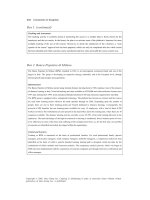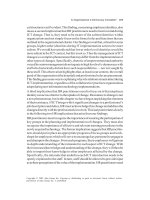Tài liệu E-Human Resource Management 25 doc
Bạn đang xem bản rút gọn của tài liệu. Xem và tải ngay bản đầy đủ của tài liệu tại đây (823.46 KB, 9 trang )
202 Comacchio & Scapolan
Copyright © 2005, Idea Group Inc. Copying or distributing in print or electronic forms without written
permission of Idea Group Inc. is prohibited.
Tracking and Assessment
The tracking activity is currently aimed at monitoring the access to a module (that is freely chosen by the
employee) and the test results. In the future, the plan is to activate more of the platform’s functions for more
in-depth tracking of the use of the courses. Moreover, to check the satisfaction of the e-learners, a “your
opinion of the course” approval test has been prepared, which can only be completed after the whole course
has been attended and which concerns course satisfaction and how clear and usable the course content was.
Box 1. (continued)
Box 2. Banca Popolare di Milano
The Banca Popolare di Milano (BPM), founded in 1865, is an interregional commercial bank and one of the
largest in Italy. The group is developing an expansion strategy nationally, and at the European level, through
internal growth and mergers and acquisitions.
Infrastructures
The Banca Popolare di Milano started using internal distance learning back in 1988, making it one of the pioneers
of distance learning in Italy. It has had training activities available on CD-ROM and videoconference forums since
1997 and, starting from 1999, it has introduced blended solutions (FAD and classroom) supported by tutorship.
The BPM group is equipped with a widespread technology. The platform has become an extranet and the courses
are used from learning points wherever the bank operates through an LMS. Depending upon the number of
people, there are one to three learning points per branch dedicated to distance learning,. Consequently, the
network of 600 branches has one learning point available for every 15 employees, with a total of about 6,700
workers involved. The workstations are also present in the head office and in the training unit, where there are 10
computers available. The distance training activity currently covers 65-70% of the total training delivered to the
employees. The main advantage of the high investment in e-learning is considered, from a business point of view,
to be efficiency in terms of the times and codifying of the company know-how, as, for the first time, new profiles
of expertise are identified and widely developed within the organization.
Content and Learners
Training in BPM is structured on the basis of professional families. For each professional family (private
managers, private plus managers, retail company managers, portfolio managers), a competency model has been
identified on the basis of which a specific blended learning training path is designed, which provides for the
combination of online modules and classroom modules. The competency analysis process, which was begun in
2000, has been implemented with the cooperation of external companies and through interviews with branch and
office managers.
E-Learning Strategies of Italian Companies 203
Copyright © 2005, Idea Group Inc. Copying or distributing in print or electronic forms without written
permission of Idea Group Inc. is prohibited.
The most consolidated competency profile within BPM is that of the private manager and includes knowledge
pertaining to the products and services offered to the customer which in recent years have broadened to include
insurance and the complementary security, as well as knowledge of regulations (national and internal memos).
The skills to manage relations with the customer such as negotiation, customer care, and customer satisfaction
skills also fall under the expertise of the private manager.
Starting with the expertise model thus identified, a training path was designed in seven steps, each of which could
consist of online or classroom modules. As part of planning a modular approach, the learning path is sequential
and each of the didactic units is therefore a preparation for another. On average a course lasts two hours and is
broken down into didactic units of about 20-40 minutes. The individual user time envisaged for an hour of e-
learning is about one week (during working hours), branch activities permitting. The contents of the modules have
been designed with attention to the interactive elements: self-evaluation tests for the quantitative part, cases, tasks,
and interactive games. Each module also comprises supplementary activities such as commercial proposals or
bibliographies that can be called up by clicking on the screen at the user’s discretion. Among the new
professionals involved in training is that of the information broker, who is particularly significant, as s/he is
responsible for finding, researching, and cataloging data and materials useful for the definition of the content. S/he
acts, for example, as the story boarder at the moment when a certain amount of information concerning a
particular subject is necessary, and s/he also has the task of organizing the alternative subjects.
Each module is designed to include a final meeting in the classroom which has an evaluation as well as a training
purpose. The post FAD is considered to be a motivational element that is very important to stimulate the learners
at the end of the course. The path lasts nine months overall.
Services and Supports
The distance training modules are published on the learning management system, which has an
initial “Welcome on Board” session in the classroom or in a videoconference that lasts about
three hours. This session has the aim of introducing the tutors, the training environment, and
the planning of the start of the individual modules. During the Welcome on Board session, the
tutors provide all the instructions necessary for how to use the course. Two types of tutorship
are used in BPM: pull tutorship and push tutorship. Pull tutorship is done through a call center
managed by outsourcing. Push tutorship is internal and based upon the monitoring data (what
and amounts) obtained. It provides the trainees with motivation, coaching, and counseling
services. The tutors telephone the learners during the course to give ongoing encouragement
and advice to do with the course.
Box 2. Banca Popolare di Milano (continued)
204 Comacchio & Scapolan
Copyright © 2005, Idea Group Inc. Copying or distributing in print or electronic forms without written
permission of Idea Group Inc. is prohibited.
The permanent pool of tutors forms part of the training management and is composed of a minimum of two up
to a maximum of six people. The tutor is neither associated with an individual course nor a determined
number of people; he can, therefore, follow different courses and can manage an average of 150-200 learners.
The push tutor does not carry out any expert subject matter activities, which are entrusted externally to a
network of content experts. Second-level tutorship is, therefore, active upon demand, even if generally the
number of questions is filtered by the tutors. The tutors’ pushing activities and the classroom activity at the
end of the e-learning course are considered fundamental factors of success of the training path. With the
activation of the orientation and pushing services, the people who completed the training in an effective and
satisfactory manner went from an initial percentage of 13-17% (completion percentage in line with European
data) to the current percentage of 85-95%.
Tracking and Assessment
The data on the training path are gathered through an evaluation and tracking system. Dependent-learner
monitoring is done at the end of each module and during the classroom meeting at the end of the overall
training path, when both the approval evaluation by the trainees and the evaluation of their level of learning is
ascertained. Independent-learner monitoring refers to the information concerning the work done and the way
people learn (amount, times, methods of use, etc.), collected through the platform’s tracking facility. This type
of information is given to the tutors on a daily basis and is used by them in planning the push calls. The
tracking data and those of the evaluation questionnaires (both individual and as a whole) are used either
during the path or thereafter to evaluate the overall progress of the path or the time actually taken by the
learners to use it, and to review (for example the duration) and design activities for subsequent courses.
Box 2. Banca Popolare di Milano (continued)
E-Learning Strategies of Italian Companies 205
Copyright © 2005, Idea Group Inc. Copying or distributing in print or electronic forms without written
permission of Idea Group Inc. is prohibited.
Section IV
Managing IT and
Organizational Changes
206 Watson, Schwarz, & Jones
Copyright © 2005, Idea Group Inc. Copying or distributing in print or electronic forms without written
permission of Idea Group Inc. is prohibited.
Chapter IX
Is Organizational
e-Democracy Inevitable?
The Impact of
Information Technologies on
Communication
Effectiveness*
Bernadette M. Watson, University of Queensland, Australia
Gavin M. Schwarz, University of New South Wales, Australia
Elizabeth Jones, Griffith University, Australia
Abstract
In this chapter, we consider the relationships between social identity and
e-democracy in organizations that exist in the constantly changing global
business and technological environment. We also consider the inevitability
of organizational e-democracy in organizations undertaking information
technology (IT) changes, the technology at the base of e-democracy.
Through an examination of employees’ experiences of change, we









